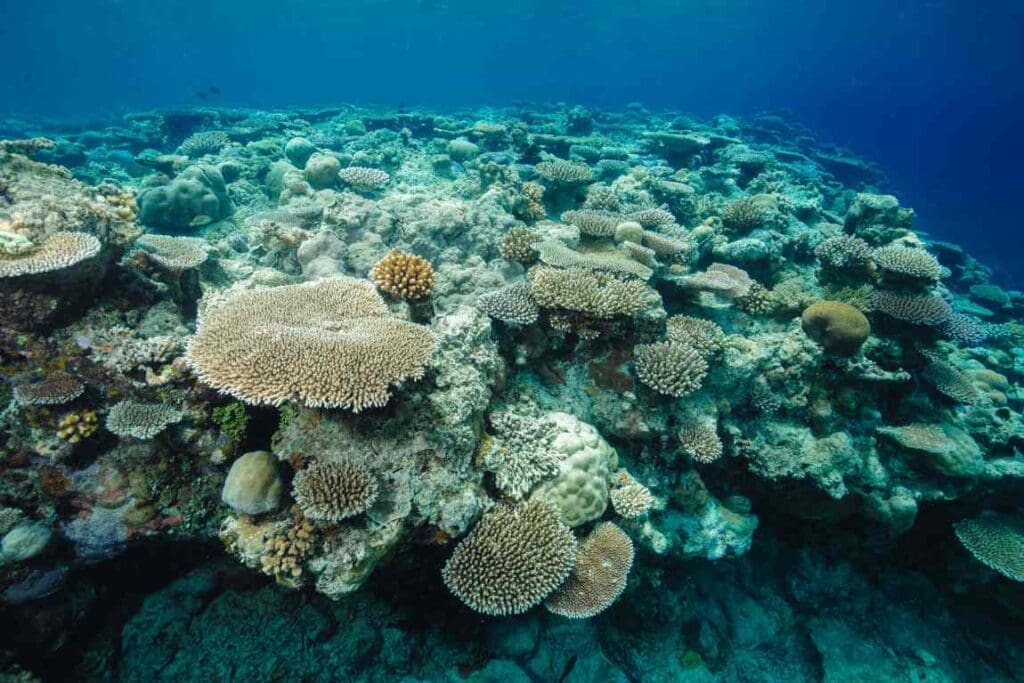Explore the latest insights from top science journals in the Muser Press roundup (November 11, 2025), featuring impactful research on climate change challenges.
In brief:
Tiny diatoms, big climate impact: How microscopic skeletons rapidly shape ocean chemistry
If you know what diatoms are, it’s probably for their beauty. These single-celled algae found on the ocean floor have ornate glassy shells that shine like jewels under the microscope.
Their pristine geometry has inspired art, but diatoms also play a key role in ocean chemistry and ecology. While they are alive, these algae contribute to the climate by drawing down carbon dioxide from the atmosphere and releasing oxygen through photosynthesis, while fueling marine food webs.
Now, a team led by Georgia Tech scientists has revealed that diatoms leave a chemical fingerprint long after they die, playing an even more dynamic role in regulating Earth’s climate than once thought.
In a study published in Science Advances, the researchers found that diatoms’ intricate, silica-based skeletons transform into clay minerals in as little as 40 days. Until the 1990s, scientists believed that this enigmatic process took hundreds to thousands of years. Recent studies whittled it down to single-digit years.

“We’ve known that reverse weathering shapes ocean chemistry, but no one expected that it happens this fast,” said Yuanzhi Tang, professor in the School of Earth and Atmospheric Sciences and senior author of the study. “This shows that the molecular-scale reactions can reverberate all the way up to influence ocean carbon cycling and, ultimately, climate.”
From Glass to Clay
When a diatom dies, most of its silica skeleton dissolves on the seafloor, returning silica to the seawater. The rest can undergo reverse weathering – a process that transforms the silica into new clay minerals containing trace metals, while turning naturally sequestered carbon back to the atmosphere as sediments react with seawater. This recycling links silicon, carbon, and trace-metal cycles, influencing ocean chemistry and stabilizing the planet’s climate over time.
Tang and her team set out to uncover how, and how quickly, reverse weathering happens. Using a custom-built, two-chamber reactor, they recreated seafloor conditions in the lab. One chamber held diatom silica, while the other contained iron and aluminum minerals. A thin membrane allowed dissolved elements to mix while keeping the solids separate.
Using advanced microscopy, spectroscopy, and chemical analyses, the researchers tracked the full transformation from the dissolution of diatom shells to the formation of new clays.
The results were striking. Within just 40 days, the diatom silica became iron-rich clay minerals – the same minerals naturally found in marine sediments.
Tang noted that this rapid transformation means that reverse weathering isn’t a slow background process, but rather an active part of the modern ocean’s chemistry. It can control how much silica stays available for diatoms to grow, how much carbon dioxide is released or stored, and how trace metals and nutrients are recycled in marine ecosystems.
“It was remarkable to see how quickly diatom skeletons could turn into completely new minerals and to decipher the mechanisms behind this process,” said Simin Zhao, the paper’s first author and a former Ph.D. student in Tang’s lab.
“These transformations are small in size but are enormous in their implications for global elemental cycles and climate,” she added.
The results suggest that the influence of reverse weathering on the coupled silicon-carbon cycles may also respond on far shorter timescales, making the ocean’s chemistry more dynamic – and potentially more sensitive to modern environmental changes.
“Diatoms are central to marine ecosystems and the global carbon pump,” said Jeffrey Krause, co-author and oceanographer at the Dauphin Island Sea Lab and the University of South Alabama. “We already knew their importance to ocean processes while living. Now we know that even after they die, diatoms’ remains continue to shape ocean chemistry in ways that affect carbon and nutrient cycling. That’s a game-changer for how we think about these processes.”
The discovery also helps solve a long-standing mystery about what happens to silica in the ocean, Tang says.
Scientists have long known that more silica enters the ocean than gets buried on the seafloor. The findings suggest that rapid reverse weathering transforms much of it into new minerals instead, keeping ocean chemistry in balance.
From Atoms to Earth Systems and Beyond
The findings offer new data for climate modelers studying how the ocean regulates atmospheric carbon. The research also lays the groundwork for improving models of ocean alkalinity and coastal acidification – key tools for predicting how the planet will respond to climate change. “This study changes how scientists think about the seafloor, not as a passive burial ground, but as a dynamic chemical engine,” Tang said.
Tang sees the study as a powerful reminder of why basic research matters. “This is where chemistry meets Earth systems,” she said. “By understanding how minerals form and exchange elements at the atomic level, we can see how the ocean shapes global cycles of carbon, silicon, and metals. Even molecular-scale reactions within hair-sized organisms can ripple outward to shape planet-level dynamics.”
The team’s next steps are to explore how environmental factors such as water chemistry influence these transformations. They also plan to use samples from coastal and deep-sea sites to see how these lab discoveries translate to natural environments.
“It’s easy to overlook what’s happening quietly in marine sediments,” Tang said. “But these subtle mineral reactions are part of the machinery that regulates Earth’s climate, and they’re faster and more beautiful than we ever imagined.”
Journal Reference:
Simin Zhao et al., ‘Rapid transformation of biogenic silica to authigenic clay: Mechanisms and geochemical constraints’, Science Advances 11, (44): eadt3374 (2025). DOI: 10.1126/sciadv.adt3374
Article Source:
Press Release/Material by Georgia Institute of Technology
Polar climate change could amplify global health risks, study warns
A study by an international team of scientists led by Professor Gail Whiteman from the University of Exeter Business School presents a comprehensive framework mapping the complex connections between physical changes in the Arctic and Antarctic which could amplify climate impacts to human health worldwide.
The researchers reviewed a wide range of scientific literature across climate science, public health and other fields. They found that current models underestimate the direct and indirect impacts of changing polar regions on global health issues – from chronic disease to mental health challenges, and pregnancy complications.
They call for these amplified health risks to be integrated into health planning and policy.
“Polar change is not a distant crisis,” said Netra Naik, Research Fellow at Arctic Basecamp and lead author of the paper. “Our review of the research shows that melting ice sheets, rising sea levels and shifting weather patterns have complex consequences that extend far beyond the Arctic and Antarctic – affecting food security, disease burden and health infrastructure. This is not just an environmental issue, but a global health emergency.”
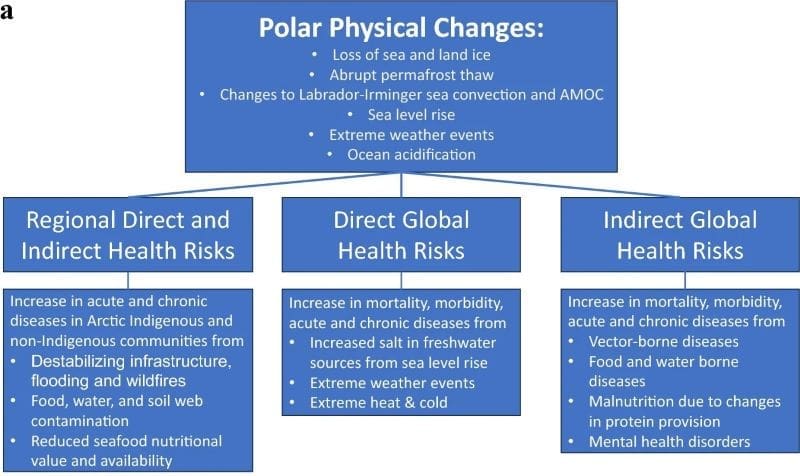
The study outlines how the polar regions, which are warming faster than the global average, are likely to trigger feedback loops and tipping cascades, reshaping global health risks in complicated and interlinked ways.
As rising temperatures weaken the jet stream and disrupt ocean currents, extreme weather is expected to drive up rates of severe injury, fatalities, and mental health disorders.
A seasonally ice-free Arctic is likely to contribute to a rise in the frequency and severity of El Niño episodes, worsening heatwaves, especially in tropical areas. Rising temperatures are expected to increase diseases including kidney and cardiovascular disease.
Sea level rise, driven by ice-sheet melt, could increase the salinity of ground water, and contaminate drinking water – potentially leading to increases in pre-eclampsia in pregnancy, infant mortality, and various types of cancer.
Polar warming could affect agricultural productivity indirectly– via disrupted precipitation and temperature patterns – increasing malnutrition-related disease.
Meanwhile, the warming climate is pushing insect and animal-borne diseases such as vibriosis, dengue fever, and Lyme disease into northern regions previously unaffected.
Flooding, intensified by polar ice melt, is increasing the spread of waterborne diseases such as cholera and typhoid, while also exacerbating respiratory conditions.
In the Arctic itself, melting permafrost and sea ice threaten vital infrastructure and risk releasing long-trapped pollutants, and even ancient pathogens, such as the 1918 influenza virus.
Ocean ecosystem shifts are also undermining traditional food sources, heightening rates of malnutrition, miscarriages, kidney failure, and cardiovascular disease among Arctic communities with fragile healthcare systems.

The study also highlights the risks to traditional food sources due to ocean ecosystem changes, contributing to rising rates of malnutrition, miscarriages, kidney failure, and cardiovascular disease among Arctic communities already facing fragile healthcare systems.
The new framework sets out the link between polar physical changes, and direct and indirect, regional and global health risks, and calls for greater integration of the health risks amplified by physical polar changes into human health impact assessments.
“Ignoring these potential drivers of disease and death is not an option,” said Professor Whiteman, Hoffmann Impact Professor for Accelerating Action on Nature and Climate. “We need stronger international collaboration between climate scientists, health professionals, and data experts to prevent harm and prepare our systems for the challenges ahead.”
The study, published in Ambio: A Journal of Environment and Society, forms part of a research project conducted jointly by the University of Exeter, Arctic Basecamp and the World Economic Forum that looks at the effects of polar climate change on global health and healthcare by building new impact assessment tools. The “Effects of Polar Climate Change on Global Health and Healthcare” project, funded by the Wellcome Trust, aims to highlight the under-reported risks posed by polar tipping points to global health and the healthcare sector.
It will enrich existing climate health analyses to support the creation of resilience strategies for the most vulnerable regions by taking into account the impact of polar tipping points.
Journal Reference:
Naik, N., Bot, K., Whiteman, G. et al., ‘A framework for assessing global health impacts of polar change: An urgent call for interdisciplinary research’, Ambio (2025). DOI: 10.1007/s13280-025-02255-0
Article Source:
Press Release/Material by Russell Parton | University of Exeter
Climate change expands wildfire danger worldwide: New study warns of unprecedented risks in the coming decades
Key findings:
- By 2040, at least 55% of the world’s fire-prone regions will experience significant increases in fire danger, regardless of emission scenario;
- By 2100, between 68% and 91% of fire-prone areas could face heightened wildfire risk, depending on future emissions;
- Even areas that in the past had a relatively low risk of wildfire are subject to this increase;
- Southern Africa, the Mediterranean region, northern Asia, northeastern South America, and parts of North America expected to see most pronounced increases;
- The novel approach to studying fire risk reduces uncertainties, leading to potential benefits in targeted prevention strategies and long-term fire management.
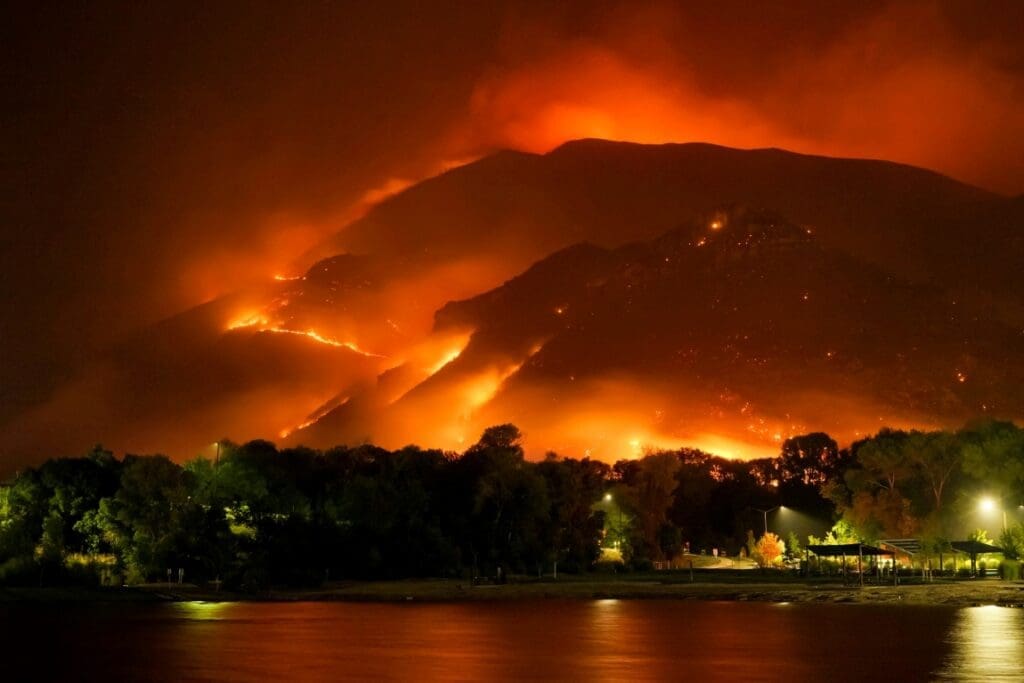
A new study, led by CMCC and Coventry University, reveals that climate change will dramatically expand wildfire danger across the globe, with up to 91% of fire-prone regions experiencing heightened risk by the end of this century.
However, these changes are not just limited to areas that are traditionally fire-prone but could also affect ones that have rarely experienced wildfire risk in the past.
“Wildfire danger is expanding and intensifying due to climate change,” says CMCC researcher and co-author of the study Maria Vincenza Chiriacò. “The key takeaway from this study is that climate-driven fire danger is not a distant or localized issue, but a growing global challenge that demands proactive action.”
Some of the most pronounced increases in fire danger are expected in regions such as southern Africa, the Mediterranean region, northern Asia, northeastern South America, and parts of North America.
“The findings highlight how climate-driven fire danger will evolve globally, with important implications for livelihoods and ecosystem resilience,” says co-author of the study and climate scientist at Coventry University, Jonathan Eden. “It’s crucial that science continues to inform policy and planning to protect forest ecosystems and communities”
Under the highest emission scenario, the projected fire danger in large parts of North America, Eurasia, South America and southern Africa could represent conditions that had less than a 1% chance of occurring during the recent historical period.
“This research is a step forward in providing more reliable projections of future fire danger under climate change, so we can better inform policy and planning, especially in regions where it is expected to rise,” says lead author of the study Carolina Gallo.
“We offer a more nuanced view of future fire risk, which is critical for long-term strategies in climate adaptation and land management,” concludes Chiriacò.
Journal Reference:
Gallo, C. et al., ‘Future Impacts of Climate Change on Global Fire Weather: Insight from Weighted CMIP6 Multimodel Ensembles’, Journal of Climate 38, 22, pp 6445–6462 (2025). DOI: 10.1175/JCLI-D-24-0540.1
Article Source:
Press Release/Material by CMCC Foundation – Euro-Mediterranean Center on Climate Change
Understanding how bacteria use “sunscreen” to adapt to climate
Cyanobacteria, commonly known as blue-green algae, are found almost everywhere in the world – from hot springs to arctic ice to antioxidant smoothies.
Part of their extreme adaptability lies within a unique light-harvesting structure called the phycobilisome. These modular antennae both collect energy from sunlight, and adapt to changing light levels in order to provide a sort of sunscreen for the bacteria.
One important way that phycobilisomes adapt involves an accessory protein to both sense and protect against too much light. But it’s not clear just how this tiny protein works.
Understanding photoprotection in phycobilisomes could inspire new biomimetic strategies for engineering plants to improve food security, or even in creating new kinds of adaptable energy technologies.
So when their collaborators in the Kerfeld Lab at Michigan State University reported a surprisingly specific molecular structure for phycobilisomes protected by this protein, University of Chicago Pritzker School of Molecular Engineering (UChicago PME) Asst. Prof. Allison Squires was intrigued.
“There are tons of places where it could bind that look just like the site that our collaborators identified, and phycobilisomes have many different architectures,” she said. “So why did it bind at this one site and not other sites? And what happens in other architectures where this specific site is blocked?”
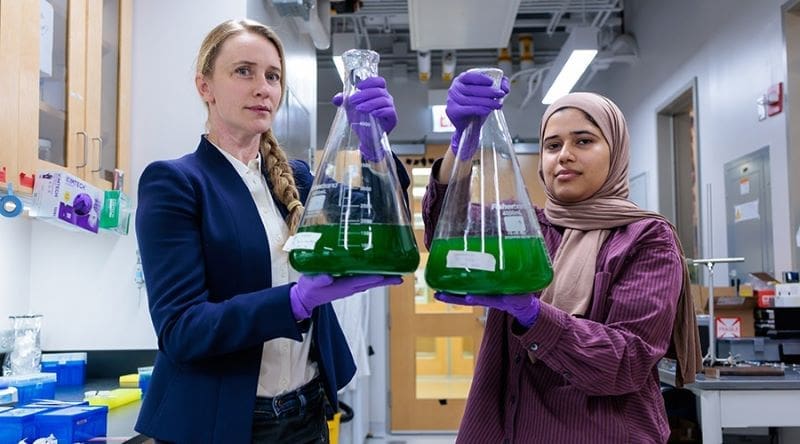
Combining high-precision spectroscopy experiments with computational modeling, Squires and her team found that in fact, this protein binds to distinct but specific sites in different phycobilisome architectures, yet still seems to work the same way, providing the same level of protection.
“It’s a really lovely example of an adaptable molecular mechanism, where the protein can easily evolve to do its job under conditions that require different phycobilisome structures,” Squires said. “Maybe it started out at one binding site, but then as the architecture changed, it could still do its job at a new site.”
The results were published in the Proceedings of the National Academy of Sciences.
Single photon spectroscopy to understand protein binding
The protein, called orange carotenoid protein, helps harvest light by “quenching” sunlight when necessary. If it’s too sunny for too long, for example, the protein binds to the phycobilisome and dissipates absorbed energy.
“Too much energy can damage the photosynthetic machinery, so having this protein provides a quick way to protect the cyanobacteria from a sudden change in light,” Squires said.
To better understand how the protein bound to the antenna structure, Squires’s team – including recent UChicago PhD graduate Ayesha Ejaz, who was the first author on the research – used single particle spectroscopy. This technology allows them to monitor energy transfer at the nanoscale. The team uses a special setup called an Anti-Brownian ELectrokinetic (ABEL) trap, which suspends their specimen in a solution and uses electrodes within a microfluidic cell to keep it in the center. That keeps the protein in place long enough to get a good signal.
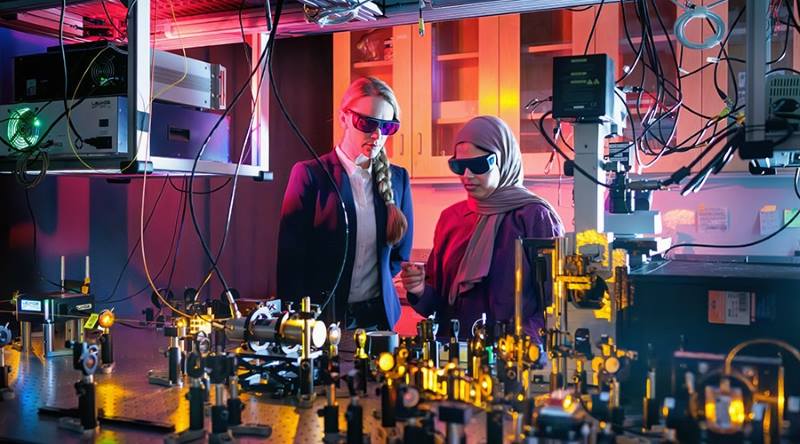
They studied how the protein bound to two different kinds of phycobilisomes – one that has a three-barrel structure, and one with a five-barrel structure – and found that the protein did indeed bind at different sites, though still provided the same quenching effect.
They also ran computer simulations that simulated a photon getting absorbed by the bacteria until it performs photosynthesis or runs into the protein.
Together, the results showed that the system “balances modularity with site specificity,” Squires said. “That’s pretty common in nature, but it really shows off the exquisite evolvability of this system.”
Next, the team hopes to delve further into the phycobilisome system to better understand how it regulates energy capture and flow. Beyond the protein, the phycobilisome seems to contain other intrinsic “switches” and “fuses” that protect against changing light conditions by breaking at the right time and location to control energy transfer. Squires and her team want to know how these other mechanisms work, and how their function complements their recent findings regarding the role of the orange carotenoid protein.
“It was very gratifying to see how the precise data obtained from the ABEL trap can be used to gain structural insights into this quenching mechanism,” Ejaz said. “I am excited to see what new patterns will emerge once we combine these results with future experiments comparing intrinsic photoprotective mechanisms among phycobilisomes with different structures.”
Collaborators on the paper include Markus Sutter, Sigal Lechno-Yossef, and Cheryl A. Kerfeld (Michigan State University and Lawrence Berkeley National Laboratory).
Journal Reference:
A. Ejaz, M. Sutter, S. Lechno-Yossef, C.A. Kerfeld, & A.H. Squires, ‘Phycobilisome core architecture influences photoprotective quenching by the Orange Carotenoid Protein’, Proceedings of the National Academy of Sciences U.S.A. 122 (41) e2420355122 (2025). DOI: 10.1073/pnas.2420355122
Article Source:
Press Release/Material by Emily Ayshford | University of Chicago
Featured image credit: Gerd Altmann | Pixabay



